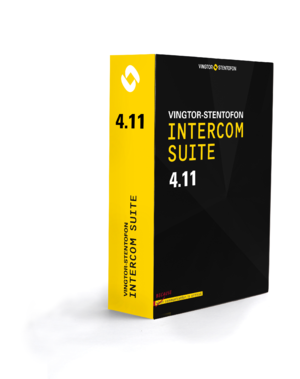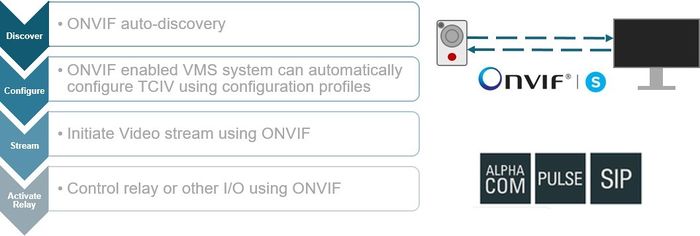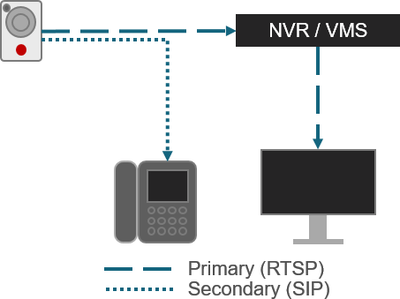Difference between revisions of "VSIS-4.11 Release"
From Zenitel Wiki
(→Vingtor-Stentofon Intercom Suite 4.11) |
|||
| (25 intermediate revisions by 2 users not shown) | |||
| Line 1: | Line 1: | ||
| + | A [[:Category:VSIS Packages|VSIS Package]] is a collection of software for intercom solutions. | ||
| + | [[Image:VS IntercomSuite 4-11.png|right|300px]] | ||
== Vingtor-Stentofon Intercom Suite 4.11 == | == Vingtor-Stentofon Intercom Suite 4.11 == | ||
| − | The VS-IS 4.11 package | + | The VS-IS 4.11 package consists of: |
| − | |||
| − | |||
* Turbine ver. 4.11.3.0 - Firmware for [[:Category:Stations#Turbine_stations|Turbine intercoms]] | * Turbine ver. 4.11.3.0 - Firmware for [[:Category:Stations#Turbine_stations|Turbine intercoms]] | ||
* INCA ver. 2.9.3.0 - Firmware for [[:Category:Stations#INCA_stations|INCA intercoms]] | * INCA ver. 2.9.3.0 - Firmware for [[:Category:Stations#INCA_stations|INCA intercoms]] | ||
| − | * VS-IMT ver. 1.4.3.5 - [[ | + | * VS-IMT ver. 1.4.3.5 - [[IMT - Intercom Management Tool|Intercom Management tool]] for PC |
* VS-Client ver. 1.3.3.2 - [[VS-Client|Soft Client]] for PULSE systems | * VS-Client ver. 1.3.3.2 - [[VS-Client|Soft Client]] for PULSE systems | ||
| + | |||
| + | Links to [[Downloads#Vingtor-Stentofon_Intercom_Suite_4.11|Software download]] and [[IMT - Discover & Upgrade|Station software Upgrade Procedure]]. | ||
== Major New Features == | == Major New Features == | ||
| Line 12: | Line 14: | ||
=== ONVIF Profile-S support on TCIV === | === ONVIF Profile-S support on TCIV === | ||
TCIV now fully supports and is compliant with the ONVIF Profile-S specification. As an industry standard, Profile-S can be used to integrate with a variety of VMS and NVR products. Both video and audio 1-way streaming is available. | TCIV now fully supports and is compliant with the ONVIF Profile-S specification. As an industry standard, Profile-S can be used to integrate with a variety of VMS and NVR products. Both video and audio 1-way streaming is available. | ||
| + | [[File:ONVIF1.jpg|thumb|left|700px]] | ||
| + | <br style="clear:both;" /> | ||
| + | |||
=== Dual-stream functionality on TCIV=== | === Dual-stream functionality on TCIV=== | ||
TCIV now supports dual-streaming functionality, with which two independent video streams can be separately initiated and controlled. Streams can be configured with different protocols (SIP, RTSP, ONVIF, HTTP), different codecs and resolutions, and are both lip-synced if audio and video are being used, using the industry-standard RTCP protocol. | TCIV now supports dual-streaming functionality, with which two independent video streams can be separately initiated and controlled. Streams can be configured with different protocols (SIP, RTSP, ONVIF, HTTP), different codecs and resolutions, and are both lip-synced if audio and video are being used, using the industry-standard RTCP protocol. | ||
| − | + | [[File:ONVIF2.png|thumb|left|400px]] | |
| + | <br style="clear:both;" /> | ||
| + | |||
| + | |||
| + | |||
=== RTSP support for TCIV video stream=== | === RTSP support for TCIV video stream=== | ||
RTSP is an industry-standard network control protocol for establishing and controlling media streams. TCIV now comes with full support for RTSP video streams. | RTSP is an industry-standard network control protocol for establishing and controlling media streams. TCIV now comes with full support for RTSP video streams. | ||
| Line 34: | Line 43: | ||
Audio and Video streams initiated using ONVIF or RTSP protocols are lip-synced for both streaming and recording, implemented using the industry-standard RTP Control Protocol (RTCP). | Audio and Video streams initiated using ONVIF or RTSP protocols are lip-synced for both streaming and recording, implemented using the industry-standard RTP Control Protocol (RTCP). | ||
| − | === Keep-alive for improved VoIP NAT traversal=== | + | === Keep-alive for improved VoIP NAT traversal (*)=== |
NAT keep-alive is a feature that sends very tiny UDP data packets from a VoIP client to the router to show that the port is still in use. Turbine are now sending keep-alives every 25 seconds. | NAT keep-alive is a feature that sends very tiny UDP data packets from a VoIP client to the router to show that the port is still in use. Turbine are now sending keep-alives every 25 seconds. | ||
| − | === IP Station support for RFC3891 SIP “Replaces” Header=== | + | === IP Station support for RFC3891 SIP “Replaces” Header (*)=== |
IP Stations now support Reinvite / INVITE with replaces, which is a quite common function used in SIP environments. The needed function is described in RFC3891. | IP Stations now support Reinvite / INVITE with replaces, which is a quite common function used in SIP environments. The needed function is described in RFC3891. | ||
| − | === IP Multicast audio support for Pulse Intercom=== | + | === IP Multicast audio support for Pulse Intercom (*)=== |
IP intercom stations now support IP multicast audio when configured in Pulse mode. Previously, only SIP mode was supported. Up to 10 multicast IP addresses can be configured. | IP intercom stations now support IP multicast audio when configured in Pulse mode. Previously, only SIP mode was supported. Up to 10 multicast IP addresses can be configured. | ||
| Line 58: | Line 67: | ||
We have added support for new Video, RTSP and ONVIF settings, syslog configuration, new DAK call actions and other smaller improvements. | We have added support for new Video, RTSP and ONVIF settings, syslog configuration, new DAK call actions and other smaller improvements. | ||
| − | + | <br> | |
| − | |||
| − | + | {{Note|Only a limited set of new functions are available for INCA intercoms. New INCA functions from table above are items with an asterix (*)}} | |
| − | |||
| − | + | <br> | |
| − | |||
| − | + | == Related information == | |
| − | + | * [[Turbine 4.11 - Release notes]] | |
| − | |||
| − | |||
| − | |||
| − | + | [[Category: VSIS Packages]] | |
Latest revision as of 13:13, 16 August 2022
A VSIS Package is a collection of software for intercom solutions.
Contents
- 1 Vingtor-Stentofon Intercom Suite 4.11
- 2 Major New Features
- 2.1 ONVIF Profile-S support on TCIV
- 2.2 Dual-stream functionality on TCIV
- 2.3 RTSP support for TCIV video stream
- 2.4 RTSP audio stream support for all Turbine devices
- 2.5 RTSP support for TCIV H.264 stream for AlphaCom systems
- 2.6 ITSV-1 new features and improvements
- 2.7 Image quality improvements for TCIV
- 2.8 Lip-sync of Audio and Video on TCIV
- 2.9 Keep-alive for improved VoIP NAT traversal (*)
- 2.10 IP Station support for RFC3891 SIP “Replaces” Header (*)
- 2.11 IP Multicast audio support for Pulse Intercom (*)
- 2.12 Chinese font on Turbine OLED display
- 2.13 TCIV-5, TKIE-3 and IP-LCM firmware support
- 2.14 Advanced GPO configuration for Pulse and SIP
- 2.15 New DAK call actions
- 2.16 VS-IMT new functions and improvements
- 3 Related information
Vingtor-Stentofon Intercom Suite 4.11
The VS-IS 4.11 package consists of:
- Turbine ver. 4.11.3.0 - Firmware for Turbine intercoms
- INCA ver. 2.9.3.0 - Firmware for INCA intercoms
- VS-IMT ver. 1.4.3.5 - Intercom Management tool for PC
- VS-Client ver. 1.3.3.2 - Soft Client for PULSE systems
Links to Software download and Station software Upgrade Procedure.
Major New Features
ONVIF Profile-S support on TCIV
TCIV now fully supports and is compliant with the ONVIF Profile-S specification. As an industry standard, Profile-S can be used to integrate with a variety of VMS and NVR products. Both video and audio 1-way streaming is available.
Dual-stream functionality on TCIV
TCIV now supports dual-streaming functionality, with which two independent video streams can be separately initiated and controlled. Streams can be configured with different protocols (SIP, RTSP, ONVIF, HTTP), different codecs and resolutions, and are both lip-synced if audio and video are being used, using the industry-standard RTCP protocol.
RTSP support for TCIV video stream
RTSP is an industry-standard network control protocol for establishing and controlling media streams. TCIV now comes with full support for RTSP video streams.
RTSP audio stream support for all Turbine devices
RTSP is an industry-standard network control protocol for establishing and controlling media streams. All Turbine intercom devices and kits now fully support RTSP for outgoing audio streams.
RTSP support for TCIV H.264 stream for AlphaCom systems
Added RTSP H.264 support on ITSV-1 to initiate video stream from TCIV in AlphaCom mode.
ITSV-1 new features and improvements
ITSV-1 has an Integrated Video preview function with TCIV and other third-party IP cameras (SIP, Pulse and AlphaCom). We have increased the number of available RTSP or HTTP MJPEG stream clients to 100. We shortened the registration interval to align it with our Pulse system. In line with our Cybersecurity strategy, constraint mode is now enabled by default, so some more advanced configuration options and tools are put behind password protection.
Image quality improvements for TCIV
Low-level optimizations were made for the AEWB engine (Automatic Exposure and White Balancing), resulting in the following image-quality improvements: better low-light performance, better overall color accuracy and contrast, and smoother, dynamic dark-light transitions.
Lip-sync of Audio and Video on TCIV
Audio and Video streams initiated using ONVIF or RTSP protocols are lip-synced for both streaming and recording, implemented using the industry-standard RTP Control Protocol (RTCP).
Keep-alive for improved VoIP NAT traversal (*)
NAT keep-alive is a feature that sends very tiny UDP data packets from a VoIP client to the router to show that the port is still in use. Turbine are now sending keep-alives every 25 seconds.
IP Station support for RFC3891 SIP “Replaces” Header (*)
IP Stations now support Reinvite / INVITE with replaces, which is a quite common function used in SIP environments. The needed function is described in RFC3891.
IP Multicast audio support for Pulse Intercom (*)
IP intercom stations now support IP multicast audio when configured in Pulse mode. Previously, only SIP mode was supported. Up to 10 multicast IP addresses can be configured.
Chinese font on Turbine OLED display
Turbine now supports Chinese language characters with a new font package. Our new vsf- chinese-font_x.x.x.x_armel.ipk package can be installed on Turbine stations. (You can find the download on AlphaWiki.)
TCIV-5, TKIE-3 and IP-LCM firmware support
Turbine firmware now supports our new TCIV-5, TKIE-3 and IP-LCM models.
Advanced GPO configuration for Pulse and SIP
Turbine now has the option to use standard Relay configuration or to use the new, more advanced GPO (output) configuration.
New DAK call actions
These new call actions have been added under DAK settings: Hold Call and Defer Call.
VS-IMT new functions and improvements
We have added support for new Video, RTSP and ONVIF settings, syslog configuration, new DAK call actions and other smaller improvements.

|
Only a limited set of new functions are available for INCA intercoms. New INCA functions from table above are items with an asterix (*) |



